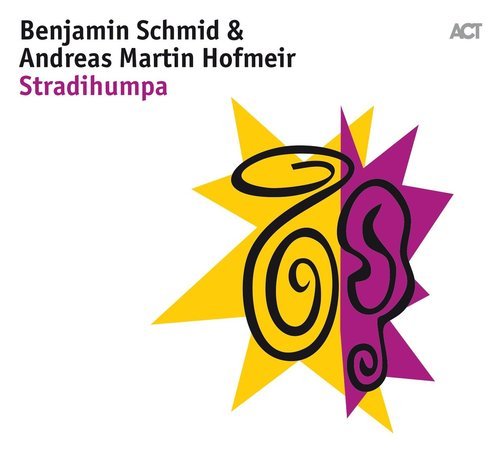Classical CDs Weekly: Beethoven, Scarlatti, Stradihumpa | reviews, news & interviews
Classical CDs Weekly: Beethoven, Scarlatti, Stradihumpa
Classical CDs Weekly: Beethoven, Scarlatti, Stradihumpa
Downsized symphonies, crystalline keyboard sonatas and a musical marriage between high and low voices

 Beethoven Revisited: Symphonies 1-9 Taschenphilharmonie/Peter Stangel (Sony)
Beethoven Revisited: Symphonies 1-9 Taschenphilharmonie/Peter Stangel (Sony)
The most enjoyable recent Beethoven symphony cycle I've heard is Yury Martynov’s set of the Liszt piano arrangements. Closely followed by this one. It’s also a left-fielder, arranged and conducted by Peter Stangel and performed by his versatile chamber-sized "pocket philharmonic orchestra". In his words, “all instruments play one-on-a-part, winds are reduced and some instruments are omitted completely, as if Beethoven had written for a large chamber ensemble.” As with this team's bewilderingly brilliant take on Mahler 7, the playing and interpretations are so effective that you soon fail to notice that anything’s out of the ordinary – plus, using modern instruments means that the sonorities aren't far off those you would get from a smallish chamber orchestra. These readings are bright, witty and brimming with intelligence. "Big" moments like the Eroica’s funeral march don’t feel undersized at all: the taut, febrile intensity overwhelms. And No. 5’s fiery, punchy opening sounds fine by me.
Symphony No. 7’s outer movements dance as you've rarely heard them dance, and its successor is a blast from start to finish. Things become a bit more conventional with No. 9. I was half hoping for just four singers, but Stangel opts for a well-drilled 20-piece choir along with the four soloists, plus a dozen extra players. It flies by, the last movement’s excesses reined in to create an unaffected, unpompous expression of joy. Recommended without hesitation: shop around, and you can pay less for this set than a round of drinks.
 Domenico Scarlatti: Sonatas Vol. 1 Federico Colli (piano) (Chandos)
Domenico Scarlatti: Sonatas Vol. 1 Federico Colli (piano) (Chandos)
We don’t know much about Domenico Scarlatti. No manuscripts survive, and there's just one extant letter in his handwriting. His music can't easily be categorised as baroque or classical, and he was as much Portuguese and Spanish as he was Italian. First-hand accounts of what he was like as a person don’t exist. On the basis of this disc, Scarlatti is someone you'd have liked to have met: this collection of his compact, single-movement keyboard sonatas is a treat. Pianist Federico Colli’s conceit is to arrange 16 of them in four thematic groups, subtitled The Power of Illusion, Live Happily!, The Return to Order and Enchantment and Prayer. It's a discursive metaphysical and musical journey, leading to an affirmation of beauty and truth. Colli even thanks an Italian professor “for his help on the philosophical questions”. If that, plus the appealing sleeve art, doesn't win you over, there's no hope.
Metaphysics aside, Colli's sequence works beautifully as a 67-minute recital. The colours he extracts from the Potton Hall Steinway are ravishing; he can be thunderous and delicate by turns. You're left awestruck by the lightness and dexterity of numbers like the KK39 Sonata in A, and reduced to tears by the more introspective numbers: sample KK208, a slowly unfolding adagio. Colli doesn't just produce flurries of brilliant sparks: we can always feel the long, lyrical lines underneath. A gorgeous collection. Scarlatti wrote 555 sonatas – let's hope that this series runs and runs.
 Benjamin Schmid & Andreas Martin Hofmeir: Stradihumpa (ACT)
Benjamin Schmid & Andreas Martin Hofmeir: Stradihumpa (ACT)
Unusual instrumental combinations don’t come much more extreme than the pairing of violin and tuba presented here. You'd expect the result to be a kind of sonic abyss, a musical sandwich with a missing filling. The disparate sounds actually blend incredibly well and you're never aware that there's anything lacking. Andreas Martin Hofmeir’s tuba playing has an agility and athleticism which defies credibility. He's got an astonishingly beautiful upper register, enabling him at certain points to soar above Benjamin Schmid on violin. There's some seriously entertaining music on this disc. Me, I was giggling throughout Jörg Duda’s little Duetto. And also during one Christof Dienz’s Concertino vom Lande, a pastoral romp taking in tractor driving and the sporadic tedium of country life, relieved by a potpourri of Austrian TV themes and advertising jingles.
1+1=3: The Abstraction of Beauty by Florian Willeitner opens with a sequence of otherwordly tuba chords, matchlessly played (and sung) by Hofmeir. There's a Wieniawski etude, hauntingly reimagined as an idiomatic violin/tuba duet, a Handel-inspired passacaglia and a foot-tapping ,jazzy Latin number. The furious pace of Antonio Bazzini’s La ronde des lutins will have you scratching your head in wonder. Guaranteed to lift the spirits: copies of Stradihumpa should be dished out by pharmacists.
Explore topics
Share this article
The future of Arts Journalism
You can stop theartsdesk.com closing!
We urgently need financing to survive. Our fundraising drive has thus far raised £49,000 but we need to reach £100,000 or we will be forced to close. Please contribute here: https://gofund.me/c3f6033d
And if you can forward this information to anyone who might assist, we’d be grateful.

Subscribe to theartsdesk.com
Thank you for continuing to read our work on theartsdesk.com. For unlimited access to every article in its entirety, including our archive of more than 15,000 pieces, we're asking for £5 per month or £40 per year. We feel it's a very good deal, and hope you do too.
To take a subscription now simply click here.
And if you're looking for that extra gift for a friend or family member, why not treat them to a theartsdesk.com gift subscription?
more Classical music
 Echo Vocal Ensemble, Latto, Union Chapel review - eclectic choral programme garlanded with dance
Beautiful singing at the heart of an imaginative and stylistically varied concert
Echo Vocal Ensemble, Latto, Union Chapel review - eclectic choral programme garlanded with dance
Beautiful singing at the heart of an imaginative and stylistically varied concert
 Scott, Irish Baroque Orchestra, Whelan, RIAM, Dublin review - towards a Mozart masterpiece
Characteristic joy and enlightenment from this team, but a valveless horn brings problems
Scott, Irish Baroque Orchestra, Whelan, RIAM, Dublin review - towards a Mozart masterpiece
Characteristic joy and enlightenment from this team, but a valveless horn brings problems
 Classical CDs: Voice flutes, flugelhorns and froth
Baroque sonatas, English orchestral music and an emotionally-charged vocal recital
Classical CDs: Voice flutes, flugelhorns and froth
Baroque sonatas, English orchestral music and an emotionally-charged vocal recital
 Kanneh-Mason, Britten Sinfonia, Shave, Milton Court - a grin and a big beaming smile
A pair of striking contemporary pieces alongside two old favourites
Kanneh-Mason, Britten Sinfonia, Shave, Milton Court - a grin and a big beaming smile
A pair of striking contemporary pieces alongside two old favourites
 theartsdesk at the New Ross Piano Festival - Finghin Collins’ musical rainbow
From revelatory Bach played with astounding maturity by a 22 year old to four-hand jazz
theartsdesk at the New Ross Piano Festival - Finghin Collins’ musical rainbow
From revelatory Bach played with astounding maturity by a 22 year old to four-hand jazz
 First Person: Manchester Camerata's Head of Artistic Planning Clara Marshall Cawley on questioning the status quo
Five days of free events with all sorts of audiences around Manchester starts tomorrow
First Person: Manchester Camerata's Head of Artistic Planning Clara Marshall Cawley on questioning the status quo
Five days of free events with all sorts of audiences around Manchester starts tomorrow
 Goldscheider, Brother Tree Sound, Kings Place review - music of hope from a young composer
Unusual combination of horn, strings and electronics makes for some intriguing listening
Goldscheider, Brother Tree Sound, Kings Place review - music of hope from a young composer
Unusual combination of horn, strings and electronics makes for some intriguing listening
 theartsdesk Q&A: composer Donghoon Shin on his new concerto for pianist Seong-Jin Cho
Classical music makes its debut at London's K-Music Festival
theartsdesk Q&A: composer Donghoon Shin on his new concerto for pianist Seong-Jin Cho
Classical music makes its debut at London's K-Music Festival
 Helleur-Simcock, Hallé, Wong, Bridgewater Hall, Manchester review - moving lyricism in Elgar’s concerto
Season opener brings lyrical beauty, crisp confidence and a proper Romantic wallow
Helleur-Simcock, Hallé, Wong, Bridgewater Hall, Manchester review - moving lyricism in Elgar’s concerto
Season opener brings lyrical beauty, crisp confidence and a proper Romantic wallow
 Kohout, Spence, Braun, Manchester Camerata, Huth, RNCM, Manchester review - joy, insight, imagination and unanimity
Celebration of the past with stars of the future at the Royal Northern College
Kohout, Spence, Braun, Manchester Camerata, Huth, RNCM, Manchester review - joy, insight, imagination and unanimity
Celebration of the past with stars of the future at the Royal Northern College

Add comment